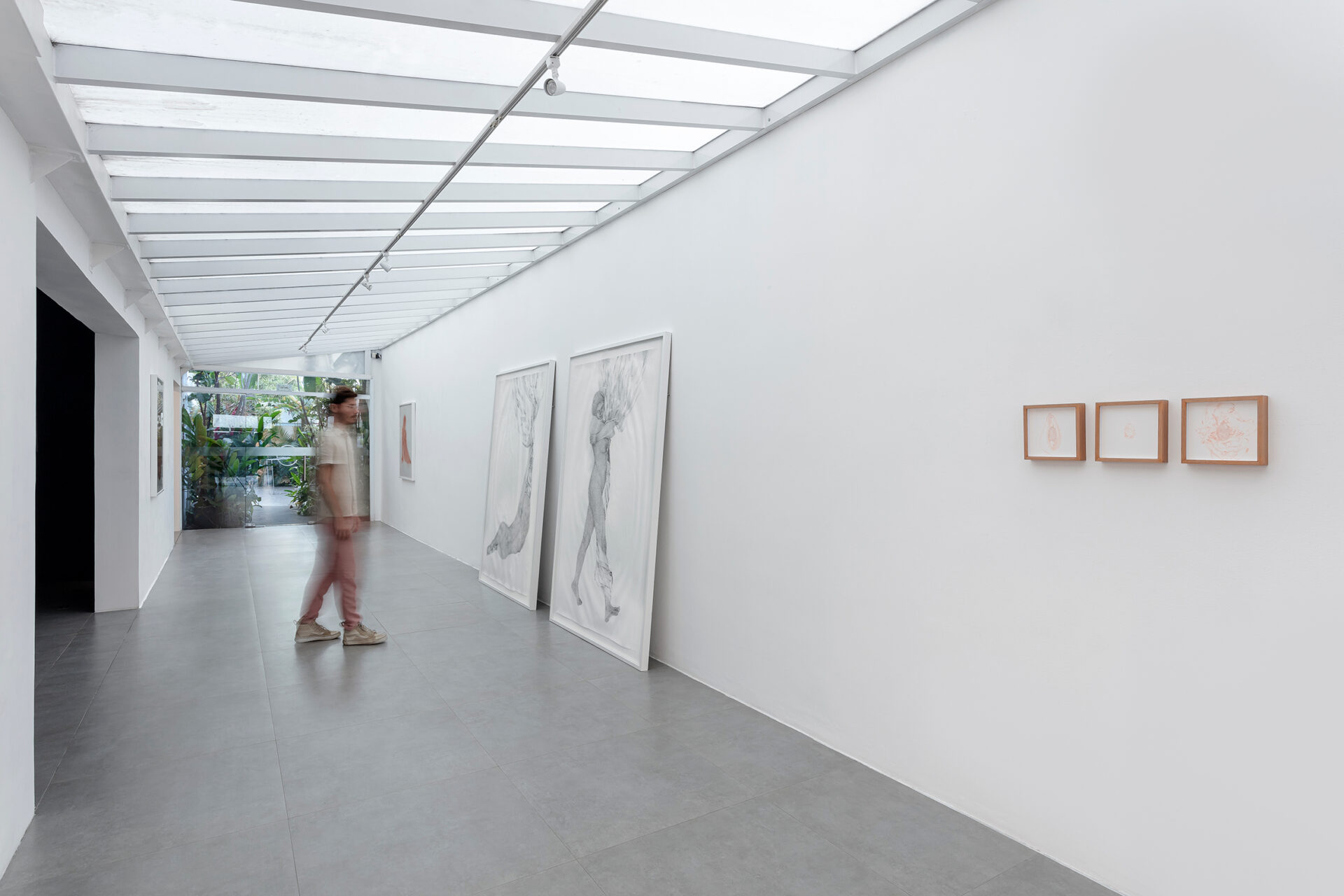Millions of kilometers separate the planets Earth and Venus, varying according to the position of their orbits. The traces of these zones could be projected through the blurs that fill these paths, dotted with light as they appear amidst so many mists.
I like to think about the fascination that occurred to Clara when creating with Venus, where the unknown conjugates as possibility and also chaos, instead of subtracting perspectives on that which is not mastered.
Balance and symmetry, so present in studies of proportion throughout the history of Western art, are no longer defining for the construction of a sense of values about drawing; there are spaces for distortions and tremors.
We learn to walk in a different way, our feet are no longer sufficient for each step, a new layer is needed to understand the density of this new path.
There is a very present characteristic in the drawings shared here, zones are defined by the shading of materials, whether charcoal, graphite, or sanguine.
There is light generated between light-dark areas and these conversations redefine the very limits of the figures, accentuating them in a mystery and enchantment.
Clara decided to look with Venusian eyes. It is a rocky planet, and so far, as we know, its environment is hostile to the human body, its high temperatures reaching maximum heat and its dense atmosphere composed mainly of carbon dioxide; these elements make it impossible for any form of life to inhabit its surface.
The movement, then, of looking like a Venusian, of being/being/living Venus, would be an articulation that arises from the unlikely, a certain cunning of imagining and recognizing that this planet, which is the closest to Earth, transforms us into a radicality as alive as the Sun and the Moon. However, we can say that we are composed of elements that originate from Venus and other celestial bodies.
The chemical elements that make up our bodies, such as carbon, oxygen, nitrogen, iron, among others, were formed inside stars through nuclear processes.
These elements were spread throughout the universe through events like supernovas and eventually aggregated to form planets, including Earth and Venus. Without conditioning Venusian life to a single iconography, but without ignoring all the eroticism that this planet brings in its Greco-Roman association, the artist complexifies the possible relations with this irradiation of Venus, linking it to spells, its geology, astronomy, astrology, and tarot.
We can almost trace a genealogy of Venus in history, always associated with the feminine aspect, named from the repetition of Western classical mythology and crystallized by Botticelli’s Renaissance painting. However, they are also linked to various artifacts from different cultures, which continue to be translated from this same cosmology. In this sense, in the process for the exhibition, the artist resumes dialogues with the researcher, curator, and astrologer Rita Venus, in an oracular conversation where they discussed an analogy of the planets from the Persian polymath Al-Biruni.
I would like to bring two passages about the wandering of very different writers about this Planet, in Delta Venus the writer Anaïs Nin brings us where one of her characters speaks about observing her own vulva through a mirror: “Thus Venus was born from the ocean, with that little seed of salty honey within her.” A little earlier, in 1953, Isaac Asimov creates a universe of stories from the planets that orbit the Sun, and at a time when it was believed that the surface of Venus was covered by water, the author creates The Oceans of Venus and in its preface of 1978, Asimov defends his narrative, admitting that as science unfolds definitions about Venus, his book is still an adventure tale and that they like it, despite the descriptions that were faithful to the time he wrote it.
Immersed in the cunning of imagination, Clara invites us to look with Venusian eyes, to see not only the unknown as possibility and chaos, but also as the primordial essence that composes us. Her process transcends the mere representation of the rocky planet, entering a cosmos of relationships in encounter with various possible readings. By amalgamating the erotic, the mythical, and the scientific, she leads us to wander through the enchanted paths of Venus, where beauty and mystery intertwine in every stroke, inviting us to explore not only outer space, but also the inner universes that echo the pulsating Venusian life that dwells within us.
Ariana Nuala
May 2024



